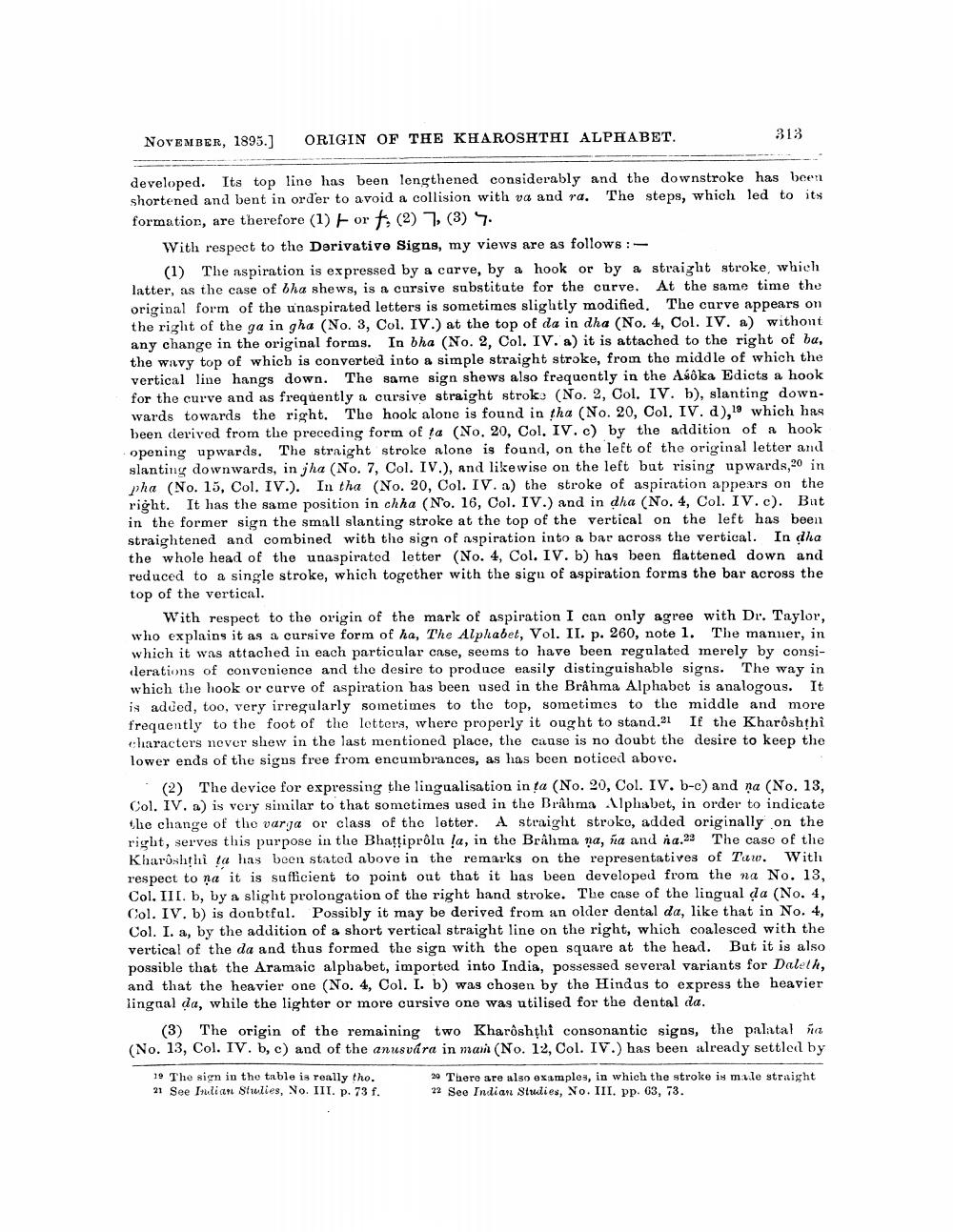________________
NOVEMBER, 1895.)
ORIGIN OF THE KHAROSHTHI ALPHABET.
313
developed. Its top lino has been lengthened considerably and the downstroke has been shortened and bent in order to avoid a collision with va and ra. The steps, which led to its formation, are therefore (1) Fort (2) 7 (3) .
With respect to the Derivative Signs, my views are as follows:
(1) The nspiration is expressed by a carve, by a hook or by a straight stroke, which latter, as the case of tha shews, is a cursive substitute for the curve. At the same time the original form of the unaspirated letters is sometimes slightly modified. The curve appears on the right of the ga in gha (No. 3, Col. IV.) at the top of da in dha (No. 4, Col. IV. a) without any change in the original forms. In bha (No. 2, Col. IV. a) it is attached to the right of ba, the wavy top of which is converted into a simple straight stroke, from the middle of which the vertical line hangs down. The same sign shews also frequently in the Asóka Edicts a hook for the curve and as frequently a cursive straight stroko (No. 2, Col. IV. b), slanting down. wards towards the right. The hook alone is found in tha (No. 20, Col. IV. d),19 which has been derived from the preceding form of ta (No. 20, Col. IV. c) by the addition of a hook opening upwards. The straight stroke alone is found, on the left of the original letter and slanting downwards, in jha (No. 7, Col. IV.), and likewise on the left but rising upwards,20 in pha (No. 15, Col. IV.). In tha (No. 20, Col. IV. a) the stroke of aspiration appears on the right. It has the same position in chha (No. 16, Col. IV.) and in dha (No. 4, Col. IV.c). But in the former sign the small slanting stroke at the top of the vertical on the left has been straightened and combined with the sign of aspiration into a bar across the vertical. In dha the whole head of the unaspirated letter (No. 4, Col. IV. b) has been flattened down and reduced to a single stroke, which together with the sign of aspiration forms the bar across the top of the vertical.
With respect to the origin of the mark of aspiration I can only agree with Dr. Taylor, who explains it as a cursive form of ha, The Alphabet, Vol. II. p. 260, note 1. The manner, in which it was attached in each particular case, seems to have been regulated merely by considerations of convenience and the desire to produce easily distinguishable signs. The way in which the hook or curve of aspiration has been used in the Brahma Alphabot is analogous. It is added, too, very irregularly sometimes to the top, sometimes to the middle and more frequently to the foot of the letters, where properly it ought to stand.21 If the Kharoshthi characters never shew in the last mentioned place, the cause is no doubt the desire to keep the lower ends of the signs free from encumbrances, as has been noticed above.
(2) The device for expressing the lingualisation in ta (No. 20, Col. IV. b-c) and na (No. 13, Col. IV. a) is very similar to that sometimes used in the Brahma Alphabet, in order to indicate the change of the varja or class of the letter. A straight stroke, added originally on the right, serves this purpose in the Bhattiprôlu !a, in the Brâhma na, ha and na.22 The case of the Kharoshshi ta has been stated above in the remarks on the representatives of Tuw. With respect to ņa it is sufficient to point out that it has been developed from the na No. 13, Col. III. b, by a slight prolongation of the right hand stroke. The case of the lingual da (No. 4, Col. IV. b) is doubtfal. Possibly it may be derived from an older dental da, like that in No. 4, Col. I. a, by the addition of a short vertical straight line on the right, which coalesced with the vertical of the da and thus formed the sign with the open square at the head. But it is also possible that the Aramaic alphabet, imported into India, possessed several variants for Daleth, and that the heavier one (No. 4, Col. I. b) was chosen by the Hindus to express the heavier lingual da, while the lighter or more cursive one was utilised for the dental da.
(3) The origin of the remaining two Kharðshthi consonantic signs, the palatal ha (No. 13, Col. IV. b, c) and of the anusvára in man (No. 12, Col. IV.) has been already settled by
19 The sign in the table is really tho. 21 See Iulian Shelies, No. III. p. 73 f.
2. There are also examples, in which the stroke in malo straight 22 See Indian Studies, No. III. pp. 03, 73.




